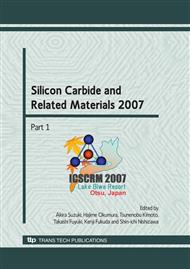p.671
p.675
p.679
p.683
p.687
p.691
p.695
p.699
p.703
Scattering Mechanisms in Silicon Carbide MOSFETs with Gate Oxides Fabricated Using Sodium Enhanced Oxidation Technique
Abstract:
The improvement of the SiC-SiO2 interface has been the main focus of research in SiC MOSFET technology due to the presence of high density of interface traps (Dit) leading to poor threshold voltage temperature stability and poor mobility. In SiC MOSFETs with the gate oxide grown in the presence of sodium, known as sodium enhanced oxidation(SEO), a lower Dit and higher field effect mobility has been observed [1]. Hall effect measurements were performed from 125°K-225°K on such MOSFET samples. The Hall measurements were made as a function of temperature for various sheet charge concentrations. The sheet charge density was measured as a function of gate bias at 225°K and there is very little trapped charge in the sample with oxide grown by SEO while about 50 % of the total charge is trapped in a sample with N2O grown oxide annealed in NO. In samples with oxide grown by SEO, there is a monotonic increase in mobility with sheet charge density and the mobility also increases with temperature. This is an indication that the main scattering mechanism is Coulomb scattering in this regime.
Info:
Periodical:
Pages:
687-690
Citation:
Online since:
September 2008
Price:
Сopyright:
© 2009 Trans Tech Publications Ltd. All Rights Reserved
Share:
Citation:


